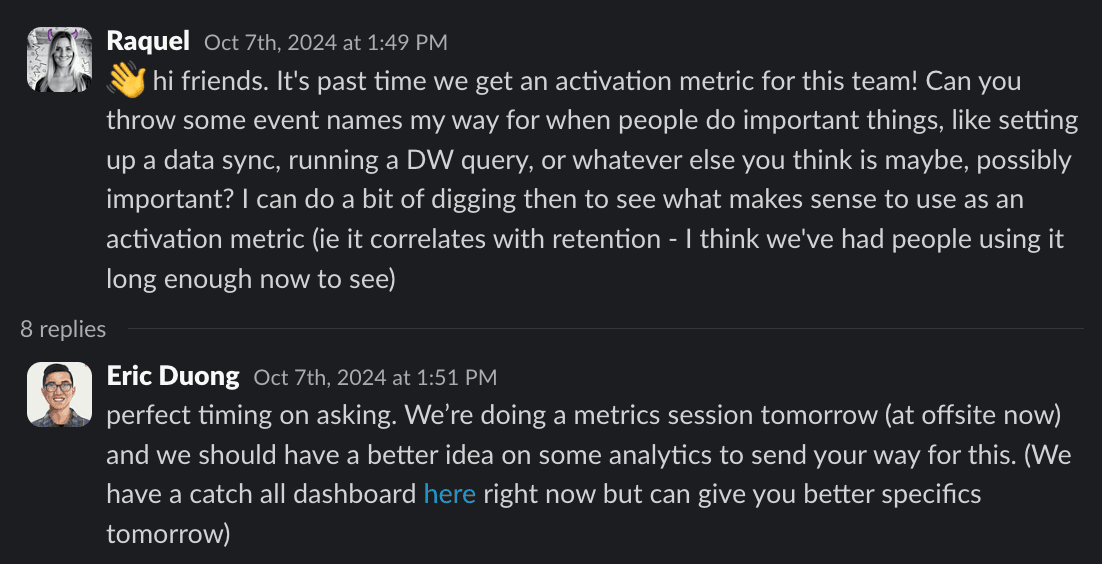-
Notifications
You must be signed in to change notification settings - Fork 479
New issue
Have a question about this project? Sign up for a free GitHub account to open an issue and contact its maintainers and the community.
By clicking “Sign up for GitHub”, you agree to our terms of service and privacy statement. We’ll occasionally send you account related emails.
Already on GitHub? Sign in to your account
Newsletter: A crash course on activation metrics #10414
base: master
Are you sure you want to change the base?
Changes from 1 commit
27ea4a9
29230ca
a39d329
b522ce3
a996939
File filter
Filter by extension
Conversations
Jump to
Diff view
Diff view
There are no files selected for viewing
| Original file line number | Diff line number | Diff line change |
|---|---|---|
| @@ -0,0 +1,156 @@ | ||
| --- | ||
| title: A crash course on activation metrics | ||
| date: 2025-01-21 | ||
| author: | ||
| - ian-vanagas | ||
| featuredImage: >- | ||
| https://res.cloudinary.com/dmukukwp6/image/upload/posthog.com/contents/images/newsletter/activation-metrics/super-hog.png | ||
| featuredImageType: full | ||
| tags: | ||
| - Engineering | ||
| crosspost: | ||
| - Product engineers | ||
| - Founders | ||
| - Blog | ||
| --- | ||
|
|
||
| In your journey to become a world-class product engineer, there is one metric that stands out in its relevance to both product and business decisions: **activation**. | ||
|
|
||
| Don't know exactly what that means, why you should care, or how to define it for your product? This post has got you covered. | ||
|
|
||
| ## Why you should care about activation metrics | ||
|
|
||
| ### 1. It's a clear starting point | ||
|
|
||
| Once you find your activation metric, it is one of the clearest ways to improve your product. Everyone, from business teams to designers to engineers, can agree that activation is important. It creates alignment between these teams. | ||
|
|
||
| There are so many [potential metrics to track](/product-engineers/b2b-saas-product-metrics). Of course, you can start by tracking general usage, but doing this doesn't really tell you anything. Activation is a metric that is relatively easy to figure out (we'll explain in the next section) and provides a clear business use. | ||
|
|
||
| ### 2. It's something engineers can actually control | ||
|
|
||
| Activation is part of the [AARRR funnel](/product-engineers/aarrr-pirate-funnel). Above it, at the top of the funnel, is acquisition which is mostly a responsibility of marketers. Engineers can't do much to acquire new users. | ||
|
|
||
| Below it is retention, revenue, and referral. The last two are mostly platform-level metrics and largely the responsibility of a smaller growth team. | ||
|
|
||
| That leaves activation and retention as the responsibilities of product engineers. Because activation is the start, it has the biggest impact on retention. It is a good first place to optimize. | ||
|
|
||
|  | ||
|
|
||
| ### 3. It's upstream of other metrics | ||
|
|
||
| In a way, activation is the base rate for the rest of your product. All of your metrics are downstream of your activation rate. Only activated users actually use your product. Having as many of them as possible is important. | ||
|
|
||
| On top of this, having a clear activation rate makes it easier to have a clear picture of other metrics down the funnel. For example, a poor referral rate could just be a product of not enough users being activated and getting there. A larger sample size (more activated users) lets you do a proper analysis of the down funnel metrics. | ||
|
|
||
| ## What makes activation tricky? | ||
|
|
||
| If you look around for how to define your activation metric, you'll find a bunch of different advice. Common ones include it being your "aha" moment or when you make your users happy. Why isn't there a simple, shared definition? | ||
|
|
||
| 1. **It's unique to your product.** There's no standard way to define activation (this is also why benchmarks suck).[^1] | ||
|
|
||
| 2. **It could be many things.** There are likely many things you want users to do in your product: complete onboarding, upload a file, share a link, watch a video. Activation could mean doing any of these (or a combination of them). | ||
|
|
||
| 3. **Activating may mean doing something multiple times.** Adding to the complexity is that someone might need to do something multiple times in order to get it. For example, to activate into our session replay product means analyzing not one but five replays. | ||
|
|
||
|  | ||
|
|
||
| ## How we find activation metrics at PostHog | ||
|
There was a problem hiding this comment. Choose a reason for hiding this commentThe reason will be displayed to describe this comment to others. Learn more. This feels like the most important part of the article, so I think it needs a bit more to make it land.
There was a problem hiding this comment. Choose a reason for hiding this commentThe reason will be displayed to describe this comment to others. Learn more. Added examples of a bunch we found I feel like adding generic examples is SOOO generic in this case and not useful. Part of the reason the Lenny article isn't a banger is because it is so generic trying to appeal to everyone. |
||
|
|
||
| At PostHog, we have a lot of experience [finding our activation metric](/product-engineers/activation-metrics). This is because we have 8+ products, each requiring their own activation metric. This metric could be some combination of 10+ events that are all important for the product. | ||
|
|
||
| Our process starts by gathering a big list of events we think might "hook" users into our product. We get these by looking at usage of that specific product and by asking customer-facing teams what they think. | ||
|
|
||
|  | ||
|
|
||
| Next, we create groups of 3-5 events to test together. We aimed for 5-10 different groups, including the number of times the event occurs (e.g. watched 5 replays vs. watched 1 replay). | ||
|
|
||
|  | ||
|
|
||
| With our potential activation event groups, we write a query to test how they correlate with retention: | ||
|
|
||
| 1. Get companies that start with our product broken down by month. We use group analytics for this, but you could just do users too. | ||
|
There was a problem hiding this comment. Choose a reason for hiding this commentThe reason will be displayed to describe this comment to others. Learn more. not everyone will know what group analytics means There was a problem hiding this comment. Choose a reason for hiding this commentThe reason will be displayed to describe this comment to others. Learn more. Explaining more |
||
|
|
||
| 2. Filter for companies who completed the activation event group in the required time. We require companies to activate within 30 days of signing up. | ||
|
There was a problem hiding this comment. Choose a reason for hiding this commentThe reason will be displayed to describe this comment to others. Learn more. why 30 days? There was a problem hiding this comment. Choose a reason for hiding this commentThe reason will be displayed to describe this comment to others. Learn more. Turns out we use a mix, so adding a comment to explain |
||
|
|
||
| 3. Calculate retention for successful companies. We check to see how many of them are still using the product 3 months after starting. | ||
|
|
||
|  | ||
|
|
||
| We then compare the retention against our product's average retention rate for all companies. We look for a retention percentage that's nominally higher than our average retention rate. | ||
|
|
||
| The above example has a retention rate of 66% for activated companies. This means: | ||
andyvan-ph marked this conversation as resolved.
Show resolved
Hide resolved
|
||
|
|
||
| - If our average retention was 50%, this would be a good activation metric 🥳. | ||
| - If our average retention was 75%, this would be a bad activation metric 😭. | ||
|
|
||
| We repeat to ensure there is a large enough sample of activated companies in the retention calculation and that one potential activation event group is dramatically better than the others. | ||
|
|
||
| > **Want to see the full real SQL query we used for this?** Check out our post on [How we found our activation metric (and how you can too)](/product-engineers/activation-metrics). | ||
|
|
||
| ## What to do with activation metric once you have it | ||
|
|
||
|  | ||
|
|
||
| ### Track it accurately | ||
ivanagas marked this conversation as resolved.
Show resolved
Hide resolved
|
||
|
|
||
| Because the events for your activation metric now stand out, it's worth investing time to make sure they are tracked accurately. This means: | ||
|
|
||
| 1. **Refining when it is captured.** For example, is it better to capture an `uploaded file` event when it *starts* or *completes*? Completed is more accurate because it removes errored and retried uploads. | ||
|
|
||
| 2. **Making sure it is firing properly.** We found that the `recording analyzed` event wasn't when we looked. | ||
|
|
||
| 3. **Capturing it on the server.** Client-side events can be ad blocked. Capturing your activation events on the server ensures you get them all. | ||
|
|
||
| ### Review it | ||
|
|
||
| Once we have an activation metric, it becomes part of our recurring growth reviews. | ||
|
|
||
| - If it has dramatic changes, figure out the causes of that. Was it a change we made? Generally, we are happy when activation stays stable. | ||
|
|
||
| - If we made changes aimed at improving activation, did they work? If not, why? If yes, is there more we can do? | ||
|
|
||
| The outcome of our growth reviews is a list of action items to do and then review in the next meeting. | ||
|
|
||
| ### See how it correlates with other areas | ||
|
|
||
| As activation is one part of the funnel, you can use it to evaluate and improve other parts of the funnel. For example, in the up-funnel | ||
|
|
||
| 1. Find out what marketing activities have an impact on activation. For example, we found that viewing two web pages before signing up leads to a dramatically higher activation rate. | ||
| 2. Target marketing and onboarding work to improve activation rates. | ||
| 3. Improve sales results by using activation as a sales lead health check. | ||
|
|
||
| In the down-funnel: | ||
|
|
||
| 1. Look at activation's impact on retention beyond 3 months. | ||
| 2. Compare revenue for activated vs non-activated users. | ||
| 3. Finding ways to convert activated users into referrers. | ||
|
There was a problem hiding this comment. Choose a reason for hiding this commentThe reason will be displayed to describe this comment to others. Learn more. Maybe I'm missing something, but surely non-activated users would just not generate revenue? I think there are probably better suggestions to make here, like refining you ICP based on how you activated users are? In fact, we should probably reference ICP a bit more earlier on – i.e. activation is an important part of narrowing down your ICP. There was a problem hiding this comment. Choose a reason for hiding this commentThe reason will be displayed to describe this comment to others. Learn more. I don't fully understand this point, I don't really know how activation can help define your ICP, it is more like vice versa (ICP -> activation), but even that I feel weakly about. |
||
|
|
||
| A special, related one for us (and other multi-product companies) is **cross-sell**. Getting people to activate into multiple products is extremely valuable to us, they are much more likely to pay and pay much more when they do. | ||
|
|
||
| Because of the importance of cross-sell, we look at how the activation of one product impacts another, figure out the "right" products for a user's lifecycle, and look for opportunities to promote "cross-activation." This is a big area of focus for our growth team upcoming. | ||
|
|
||
| ### Just improve it | ||
|
|
||
|  | ||
|
|
||
| Finally, there's only so much analyzing your activation rate you can do. Eventually, you try to improve it by helping users activate faster or providing them more motivation to activate. This is done by: | ||
|
|
||
| - Create email campaigns focused on your activation events | ||
| - Track signup to activation conversion with [funnels](/docs/product-analytics/funnels) | ||
| - Run [experiments](/docs/experiments) with your activation events as a goal metric | ||
| - Launch [surveys](/docs/surveys) asking people why they don't activate | ||
| - Connect activation to sales or revenue data with our [data warehouse](/docs/data-warehouse) | ||
|
|
||
| When I asked [Paul Copplestone](https://x.com/kiwicopple), CEO of [Supabase](https://supabase.com/), how they tried to improve their activation metric of "weekly active databases," he said: | ||
|
|
||
| > Is it ever 1 thing? This metric has many drivers: increase new databases (by increasing new signups or make it compelling for existing signups to spin up many databases), reduce churn by ensuring no scalability issues, increase the growth of the database from "just trying it out" to "using in production" by reducing friction when building, etc. | ||
|
|
||
| In our case, because `replay list filter added` is part of our activation metric, focused on changes that encourage users to use playlists like our "What to watch" tab with playlist templates: | ||
|
|
||
|  | ||
|
|
||
| <NewsletterForm /> | ||
|
|
||
| [^1]: **What about my benchmarks bro?** Lenny put together some nice benchmarks for activation but the ranges are extremely wide. Because the definition of "activation" varies between businesses, there's no real way to compare. When you are battling to increase your activation rates by single digit percentage points, having a range of 20%+ between ok and good isn't helpful. | ||
|
|
||
|
|
||
There was a problem hiding this comment.
Choose a reason for hiding this comment
The reason will be displayed to describe this comment to others. Learn more.
This section is GREAT